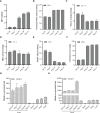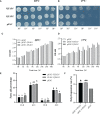Tung tree stearoyl-acyl carrier protein Δ9 desaturase improves oil content and cold resistance of Arabidopsis and Saccharomyces cerevisiae
- PMID: 36959932
- PMCID: PMC10028071
- DOI: 10.3389/fpls.2023.1144853
Tung tree stearoyl-acyl carrier protein Δ9 desaturase improves oil content and cold resistance of Arabidopsis and Saccharomyces cerevisiae
Abstract
The seed oil of tung tree is rich in a-eleostearic acid (ESA), which endows tung oil with the characteristic of an excellently dry oil. The stearoyl-acyl carrier protein δ9 desaturase (SAD) is a rate-limiting enzyme that converts the stearic acid to the oleic acid, the substrate for the production of the α-ESA. However, the function of the two predicted VfSAD1 and VfSAD2 genes in the tung tree has not been determined. In this study, quantitative real-time PCR (qRT-PCR) analysis showed that VfSAD1 and VfSAD2 were expressed in multiple organs of tung tree but were highly expressed in the seed during the oil rapid accumulation period. Heterologous expression of VfSAD1 and VfSAD2 could promote the production of oleic acid and its derivatives in Arabidopsis thaliana and yeast BY4741, indicating that VfSAD1 and VfSAD2 possess the stearoyl-ACP desaturases function. Furthermore, both VfSAD1 and VfSAD2 could significantly improve seed oil accumulation in Arabidopsis. VfSAD1 could also significantly promote the oil accumulation in the yeast BY4741 strain. In addition, overexpression of VfSAD1 and VfSAD2 enhanced the tolerance of yeast and Arabidopsis seedlings to low temperature stress. This study indicates that the two VfSAD genes play a vital role in the process of oil accumulation and fatty acid biosynthesis in the tung tree seed, and both of them could be used for molecular breeding in tung tree and other oil crops.
Keywords: oil accumulation; oleic Acid; stearoyl-acyl carrier prote in Δ9 desaturase (SAD); the α-eleostearic acid; tung tree (Vernicia fordii).
Copyright © 2023 Chen, Gao, Zhang and Zhang.
Conflict of interest statement
The authors declare that the research was conducted in the absence of any commercial or financial relationships that could be construed as a potential conflict of interest.
Figures






Similar articles
-
Molecular mechanism of the extended oil accumulation phase contributing to the high seed oil content for the genotype of tung tree (Vernicia fordii).BMC Plant Biol. 2018 Oct 19;18(1):248. doi: 10.1186/s12870-018-1458-3. BMC Plant Biol. 2018. PMID: 30340540 Free PMC article.
-
Triacylglycerol biosynthesis in shaded seeds of tung tree (Vernicia fordii) is regulated in part by Homeodomain Leucine Zipper 21.Plant J. 2021 Dec;108(6):1735-1753. doi: 10.1111/tpj.15540. Epub 2021 Oct 27. Plant J. 2021. PMID: 34643970
-
Tung Tree (Vernicia fordii) Genome Provides A Resource for Understanding Genome Evolution and Improved Oil Production.Genomics Proteomics Bioinformatics. 2019 Dec;17(6):558-575. doi: 10.1016/j.gpb.2019.03.006. Epub 2020 Mar 26. Genomics Proteomics Bioinformatics. 2019. PMID: 32224189 Free PMC article.
-
[Identification and functional analysis of soybean stearoyl-ACP Δ⁹ desaturase (GmSAD) gene family].Sheng Wu Gong Cheng Xue Bao. 2020 Apr 25;36(4):716-731. doi: 10.13345/j.cjb.190550. Sheng Wu Gong Cheng Xue Bao. 2020. PMID: 32347066 Chinese.
-
Structure and Function of Δ9-Fatty Acid Desaturase.Chem Pharm Bull (Tokyo). 2019;67(4):327-332. doi: 10.1248/cpb.c18-01001. Chem Pharm Bull (Tokyo). 2019. PMID: 30930436 Review.
Cited by
-
Drought-induced 19 gene FvDi19-3 from woodland strawberry enhances drought and salt tolerance in transgenic Arabidopsis.Plant Cell Rep. 2025 Apr 7;44(5):94. doi: 10.1007/s00299-025-03481-2. Plant Cell Rep. 2025. PMID: 40192848
-
Genome-Wide Identification and Expression Analysis of the Stearoyl-Acyl Carrier Protein Δ9 Desaturase Gene Family under Abiotic Stress in Barley.Int J Mol Sci. 2023 Dec 21;25(1):113. doi: 10.3390/ijms25010113. Int J Mol Sci. 2023. PMID: 38203283 Free PMC article.
References
-
- Cui P., Lin Q., Fang D. M., Zhang L. L., Li R. J., Cheng J. Y., et al. . (2018). Tung tree (Vernicia fordii, hemsl.) genome and transcriptome sequencing reveals Co-ordinate up-regulation of fatty acid beta-oxidation and triacylglycerol biosynthesis pathways during eleostearic acid accumulation in seeds. Plant Cell Physiol. 59 (10), 1990–2003. doi: 10.1093/pcp/pcy117 - DOI - PubMed
-
- De Palma M., Grillo S., Massarelli I., Costa A., Balogh G., Vigh L., et al. . (2008). Regulation of desaturase gene expression, changes in membrane lipid composition and freezing tolerance in potato plants. Mol. Breed. 21 (1), 15–26. doi: 10.1007/s11032-007-9105-y - DOI
LinkOut - more resources
Full Text Sources

